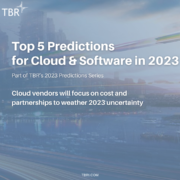Top 5 Predictions for Cloud & Software Vendors in 2023
Update: Download your free copy of TBR’s Top Cloud Predictions for 2024 special report, GenAI: A Growth Catalyst for Cloud Evolution in 2024 and Beyond
Cloud vendors will use predictable strategies for unprecedented times in 2023
Top 5 predictions for Cloud and Software vendors in 2023
- Cost comes back into vogue
- The big and small get bigger
- Cloud growth is generated by partnerships
- Looking to meet a new set of business-led use cases, hyperscalers invest in cloud-native PaaS, but not without infringing on partners
- SaaS vendors will more aggressively pursue solution up- and cross- sell to expand client ARPU and weather economic pressures
Vendors will focus on cost and partnerships to weather 2023 uncertainty
2023 will mark the first time the mature cloud market has been tested. Cloud served as an alternative IT cost-savings measure in the wake of the 2008 financial crisis, but it is no longer a small, insignificant portion of the average customer’s IT budget.
While cloud spending and the overall market opportunity will continue to expand in the coming year, we expect that growth to be altered by the macroeconomic environment. In response, we believe cloud vendors will go back to basics, focusing on cost and employing the assistance of their maturing ecosystems to weather the environment.
As a reflection of the uncertainty felt by customers, and the pullback and spending that will result, many cloud decisions will be based on cost savings yet again. The benefits of agility, innovation and business expansion will remain at the core of cloud purchasing decisions, but a thorough evaluation of the cost of cloud versus that of alternative solutions will play more of a role in 2023 than in the preceding years.
Vendors in the cloud space may face slightly longer sales cycles, additional financial scrutiny and increased negotiation to secure deals. We also expect to see more competition and growth from vendors below the top tier of cloud providers. As more significant workloads have moved to cloud, the need for complementary solutions like data management and security has increased.
Lastly, cloud partnerships will underpin the growth that will occur — albeit it at a slower rate than has been seen over the past five years. The growth of indirect cloud revenue, through systems integration engagements, cloud-based ISVs, managed service providers and resellers, will play a pivotal role in the continued expansion of the market. We expect these trends to shape the cloud market in the face of an unprecedented challenge in 2023.
TBR’s 2023 Predictions is a special series examining market trends and business changes in key markets. Covered segments include cloud & software, devices, digital transformation, IT infrastructure, professional services, federal IT services and telecom.

 Technology Business Research, Inc.
Technology Business Research, Inc. Technology Business Research, Inc.
Technology Business Research, Inc. Technology Business Research, Inc.
Technology Business Research, Inc.